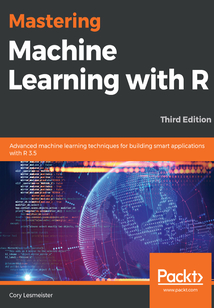舉報 

會員
Mastering Machine Learning with R
GiventhegrowingpopularityoftheR-zerocoststatisticalprogrammingenvironment,therehasneverbeenabettertimetostartapplyingMLtoyourdata.ThisbookwillteachyouadvancedtechniquesinML,using?thelatestcodeinR3.5.Youwilldelveintovariouscomplexfeaturesofsupervisedlearning,unsupervisedlearning,andreinforcementlearningalgorithmstodesignefficientandpowerfulMLmodels.Thisnewlyupdatededitionispackedwithfreshexamplescoveringarangeoftasksfromdifferentdomains.MasteringMachineLearningwithRstartsbyshowingyouhowtoquicklymanipulatedataandprepareitforanalysis.Youwillexploresimpleandcomplexmodelsandunderstandhowtocomparethem.You’llalsolearntousethelatestlibrarysupport,suchasTensorFlowandKeras-R,forperformingadvancedcomputations.Additionally,you’llexplorecomplextopics,suchasnaturallanguageprocessing(NLP),timeseriesanalysis,andclustering,whichwillfurtherrefineyourskillsindevelopingapplications.EachchapterwillhelpyouimplementadvancedMLalgorithmsusingreal-worldexamples.You’llevenbeintroducedtoreinforcementlearning,alongwithitsvarioususecasesandmodels.Intheconcludingchapters,you’llgetaglimpseintohowsomeoftheseblackboxmodelscanbediagnosedandunderstood.Bytheendofthisbook,you’llbeequippedwiththeskillstodeployMLtechniquesinyourownprojectsoratwork.
目錄(174章)
倒序
- coverpage
- Title Page
- Copyright and Credits
- Mastering Machine Learning with R Third Edition
- About Packt
- Why subscribe?
- Packt.com
- Contributors
- About the author
- About the reviewers
- Packt is searching for authors like you
- Preface
- Who this book is for
- What this book covers
- To get the most out of this book
- Download the example code files
- Download the color images
- Conventions used
- Get in touch
- Reviews
- Preparing and Understanding Data
- Overview
- Reading the data
- Handling duplicate observations
- Descriptive statistics
- Exploring categorical variables
- Handling missing values
- Zero and near-zero variance features
- Treating the data
- Correlation and linearity
- Summary
- Linear Regression
- Univariate linear regression
- Building a univariate model
- Reviewing model assumptions
- Multivariate linear regression
- Loading and preparing the data
- Modeling and evaluation – stepwise regression
- Modeling and evaluation – MARS
- Reverse transformation of natural log predictions
- Summary
- Logistic Regression
- Classification methods and linear regression
- Logistic regression
- Model training and evaluation
- Training a logistic regression algorithm
- Weight of evidence and information value
- Feature selection
- Cross-validation and logistic regression
- Multivariate adaptive regression splines
- Model comparison
- Summary
- Advanced Feature Selection in Linear Models
- Regularization overview
- Ridge regression
- LASSO
- Elastic net
- Data creation
- Modeling and evaluation
- Ridge regression
- LASSO
- Elastic net
- Summary
- K-Nearest Neighbors and Support Vector Machines
- K-nearest neighbors
- Support vector machines
- Manipulating data
- Dataset creation
- Data preparation
- Modeling and evaluation
- KNN modeling
- Support vector machine
- Summary
- Tree-Based Classification
- An overview of the techniques
- Understanding a regression tree
- Classification trees
- Random forest
- Gradient boosting
- Datasets and modeling
- Classification tree
- Random forest
- Extreme gradient boosting – classification
- Feature selection with random forests
- Summary
- Neural Networks and Deep Learning
- Introduction to neural networks
- Deep learning – a not-so-deep overview
- Deep learning resources and advanced methods
- Creating a simple neural network
- Data understanding and preparation
- Modeling and evaluation
- An example of deep learning
- Keras and TensorFlow background
- Loading the data
- Creating the model function
- Model training
- Summary
- Creating Ensembles and Multiclass Methods
- Ensembles
- Data understanding
- Modeling and evaluation
- Random forest model
- Creating an ensemble
- Summary
- Cluster Analysis
- Hierarchical clustering
- Distance calculations
- K-means clustering
- Gower and PAM
- Gower
- PAM
- Random forest
- Dataset background
- Data understanding and preparation
- Modeling
- Hierarchical clustering
- K-means clustering
- Gower and PAM
- Random forest and PAM
- Summary
- Principal Component Analysis
- An overview of the principal components
- Rotation
- Data
- Data loading and review
- Training and testing datasets
- PCA modeling
- Component extraction
- Orthogonal rotation and interpretation
- Creating scores from the components
- Regression with MARS
- Test data evaluation
- Summary
- Association Analysis
- An overview of association analysis
- Creating transactional data
- Data understanding
- Data preparation
- Modeling and evaluation
- Summary
- Time Series and Causality
- Univariate time series analysis
- Understanding Granger causality
- Time series data
- Data exploration
- Modeling and evaluation
- Univariate time series forecasting
- Examining the causality
- Linear regression
- Vector autoregression
- Summary
- Text Mining
- Text mining framework and methods
- Topic models
- Other quantitative analysis
- Data overview
- Data frame creation
- Word frequency
- Word frequency in all addresses
- Lincoln's word frequency
- Sentiment analysis
- N-grams
- Topic models
- Classifying text
- Data preparation
- LASSO model
- Additional quantitative analysis
- Summary
- Creating a Package
- Creating a new package
- Summary
- Other Books You May Enjoy
- Leave a review - let other readers know what you think 更新時間:2021-07-02 13:46:47
推薦閱讀
- 3D Printing with RepRap Cookbook
- Java開發技術全程指南
- 圖解PLC控制系統梯形圖和語句表
- JMAG電機電磁仿真分析與實例解析
- 人工智能與人工生命
- Windows內核原理與實現
- Ceph:Designing and Implementing Scalable Storage Systems
- 步步圖解自動化綜合技能
- Hadoop應用開發基礎
- 激光選區熔化3D打印技術
- 大數據案例精析
- PowerMill 2020五軸數控加工編程應用實例
- 寒江獨釣:Windows內核安全編程
- Web編程基礎
- 基于Quartus Ⅱ的數字系統Verilog HDL設計實例詳解
- 工業機器人技術
- 傳感器應用技術
- 輸送技術、設備與工業應用
- 局域網組建與使用完全自學手冊
- 人工智能基礎教程:Python篇(青少版)
- Mac OS X 10.8 Mountain Lion中文版入門
- R Deep Learning Projects
- Excel 2010行政與文秘應用
- 機器學習技術及應用
- Illustrator CS5插畫藝術
- 深度強化學習核心算法與應用
- 工業機器人:產品包裝典型應用精析
- Creo 6.0中文版完全自學手冊(第3版)
- Excel 2007公式、函數與圖表應用
- 單片機原理與應用系統設計

